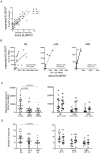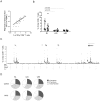Effect of maraviroc intensification on HIV-1-specific T cell immunity in recently HIV-1-infected individuals
- PMID: 24475275
- PMCID: PMC3903883
- DOI: 10.1371/journal.pone.0087334
Effect of maraviroc intensification on HIV-1-specific T cell immunity in recently HIV-1-infected individuals
Abstract
Background: The effect of maraviroc on the maintenance and the function of HIV-1-specific T cell responses remains unknown.
Methods: Subjects recently infected with HIV-1 were randomized to receive anti-retroviral treatment with or without maraviroc intensification for 48 weeks, and were monitored up to week 60. PBMC and in vitro-expanded T cells were tested for responses to the entire HIV proteome by ELISpot analyses. Intracellular cytokine staining assays were conducted to monitor the (poly)-functionality of HIV-1-specific T cells. Analyses were performed at baseline and week 24 after treatment start, and at week 60 (3 months after maraviroc discontinuation).
Results: Maraviroc intensification was associated with a slower decay of virus-specific T cell responses over time compared to the non-intensified regimen in both direct ex-vivo as well as in in-vitro expanded cells. The effector function profiles of virus-specific CD8⁺ T cells were indistinguishable between the two arms and did not change over time between the groups.
Conclusions: Maraviroc did not negatively impact any of the measured parameters, but was rather associated with a prolonged maintenance of HIV-1-specific T cell responses. Maraviroc, in addition to its original effect as viral entry inhibitor, may provide an additional benefit on the maintenance of virus-specific T cells which may be especially important for future viral eradication strategies.
Conflict of interest statement
Figures




References
-
- Samson M, Libert F, Doranz BJ, Rucker J, Liesnard C, et al. (1996) Resistance to HIV-1 infection in caucasian individuals bearing mutant alleles of the CCR-5 chemokine receptor gene. Nature 382: 722–725. - PubMed
-
- Liu R, Paxton WA, Choe S, Ceradini D, Martin SR, et al. (1996) Homozygous defect in HIV-1 coreceptor accounts for resistance of some multiply-exposed individuals to HIV-1 infection. Cell 86: 367–377. - PubMed
-
- Paxton WA, Liu R, Kang S, Wu L, Gingeras TR, et al. (1998) Reduced HIV-1 infectability of CD4+ lymphocytes from exposed-uninfected individuals: association with low expression of CCR5 and high production of beta-chemokines. Virology 244: 66–73. - PubMed
Publication types
MeSH terms
Substances
LinkOut - more resources
Full Text Sources
Other Literature Sources
Medical
Research Materials

